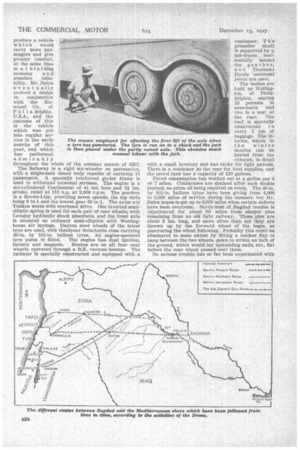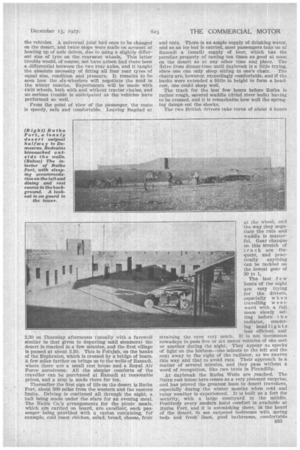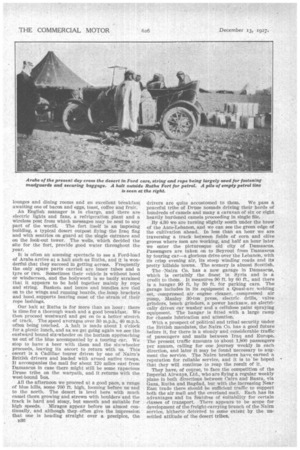MAILS BY SIX-WHEELER 1 THE SYRIAN DESERT.
Page 50

Page 51

Page 52

Page 53

Page 54

If you've noticed an error in this article please click here to report it so we can fix it.
An Impression of the Nairn Transport Damascus and Beyrout, Gained by ( ce in Operation Between Bagdad and unbay Correspondent in a Journey a Across the Desert. Recently Undertaken 1
AN article appeared in the issue of The Comm:Trial Motor for September 7th, 1926, on the pioneer work done by the brothers Norman and Gerald Nairn in establisning a regular motor service across the Syrian Desert, between Beyrout and Bagdad, culminating with the introduction of .-a Safeway six-wheeler bus on pneumatic tyres, carrying 15 passengers and having two drivers, the trials of which took place just before the article was published. A fleet of these vehicles was put on the regular weekly service early in the present year, and we are now able to publish an account of the service by our own correspondent, who recently traversed the desert by this route, especially to report upon the service after the new vehicles had been running for six months.
For those of our readers who did not see the previous article, it may be as well to give a very brief history of the Nairn concern. Mr. Norman Nairn, who had served with the R...4.S.C. Mechanical Transport in Palestine during the war, started a motor business in Beyrout after hostilities were over and ran a mail and passenger service along the coast between Beyrout and ' the railhead at Haifa. He saw the commercial possibilities of a motor service between Bagdad and the Mediterranean to obviate" the long mail route from London via Bombay and Basra, and in April, 1023, he and a small party made the crossing in four days, using two Buick and two Dodge cars. A regular weekly service was commenced in October, 1923, via Damascus and Raba, using Cadiliac cars, which were very satisfactory mechanically, although riot ideal vehicles for the job. They carried four passengers, luggage, about 50 gallons .of petrol in tanks on the running boards, food and water, and were driven by a single driver all the way, covering the 600 miles in 24 to 30 hours. After much experimenting, high-pressure tyres of large section were found to give the best service. The Cadillacs consumed about a gallon of petrol per 11 miles. It was thought that Cadillac
limousineseight passengers would be more suitable, ad effect was given to this idea, but the fast
going over the uneven desert surface was too much for the bodywork.
By the summer of 1925 the desert route had achieved very great popularity and good progress in the develop. ment of the traffic had been made. Natives were also operating with cars of various makes, but found little favour with Europeans, as they could not provide the security or the reliability which were indispensable.
One other company, namely, the Eastern Transport Co., who had pioneered a northern route with Dodge and Panhard ears, was running a service via Palmyra and Hit on the Euphrates. But then came the revolt of the Druse of Southern Syria against the French. rule, rendering the desert. east of Damascus dangerous. The Nairn Co. made a new route from Jerusalem via Jericho, Amman and Rutba, which was 200 miles longer and very bad of surface in some parts, but which enabled the service to be maintained. The Eastern Transport 0o. meanwhile ran from Tripoli on 'the Syrian coast via Horns and Palmyra, and this route was also adopted by the Nairn Co. in the winter of 1925, when the French authorities undertook to protect it. About a year later, however, when the Arabs became more peaceable, reversion was made to the short route via Damascus and Rutba Wells. Our sketch map of the country will give an idea of the different routes that have been explored and their relation to the political boundaries. .!
Investigations were on foot throughout this period to produce a vehicle which would carry more passengers and give greater comfort, at the same time m a i ntai ning economy and absolute reliability. Mr. Nairn event u ally evolved a design in conjunction ivith the Sixwheel Co., of Phila delphia, U.S.A., and the outcome of this is the vehicle which was put into regular ser vice in the early months of this year, and which has performed admirably throughout the whole of the summer season of 1927.
The Safeway is a rigid six-wheeler on pneumatics, with a single-deck closed body capable of carrying 15 passengers. A specially reinforced girder frame is used to withstand torsional stresses. The engine is a six-cylindered Continental of 4+ ins, bore and 5* ins. stroke, rated at 110 h.p. at 2,000 r.p.m. The gearbox Is a Brown-Lipe, providing seven speeds, the top ratio being 6 to 1 and the lowest gear 50 to 1. The axles are Timken worm with overhead drive. One Inverted semielliptic spring is used for each pair of rear wheels, with Lovejoy hydraulic shock absorbers, and the front axle Is mounted on ordinary semi-elliptics with Westinghouse air springs. Dayton steel wheels of the latest type are used, with Goodyear detachable rims carrying 40-in. by 101-in, balloon tyres. An engine-operated tyre pump is fitted. The engine has dual ignition, battery and magneto. Brakes are on all four rear wheels, operated through a B.K. vacuum booster. The radiator Is specially constructed and equipped with a -77 condenser. The propeller shaft is supported by a sub-frame horizontally behind the gearbox, a nil Thermoid Hardy universal joints are used.
The bodies are built by Wolfington, of Phila.; delphia, seating 13 persons in armchairs and two in a seat at the rear. The roof is specially constructed to carry 1 ton of baggage. The interior, which in the winter months can be heated from the exhaust, is fitted with a small lavatory and has racks for light parcels. There is a container at the rear for food supplies, and the petrol tank has a capacity of 120 gallons.
Petrol consumption has worked out at a gallon per 6 or 7 miles. Crankcases are drained after each double journey, no extra oil being required en route. The 40-in. by 10+-in. balloon tyres have been giving from 4,000 to 5,000 miles of service during the summer, but Mr. Nairn hopes to get up to 8,000 miles when certain defects have been overcome. North-west of Bagdad trouble is experienced for about 60 miles from sleeper pins remaining from an old light railway. These pins are about 3 ins, long, and more often than not they are thrown up by the forward wheel of the bogie, so puncturing the wheel following. Probably this could be eliminated to some extent by fitting a leather flap to hang between the two wheels, down to within an inch of the ground, which would lay upstanding nails, etc., flat before the rear wheel passed over them.
No serious trouble has so far been experienced with the vehicles. A universal joint had once to be changed on the desert, and twice steps were made on account of heating up of axle drives, due to using a slightly different size of tyre on the rearmost wheels. This latter trouble would, of course. not have arisen had there been a differential between the two rear axles, and it taught the absolute necessity of fitting all feur rear tyres of equal size, condition and pressure. It remains to he seen how the six-wheelers will negotiate the mud in the winter months. Experiments will be made with • twit wheels, both with, and without tractor chains, and no serious trouble is anticipated as the vehicles have performed so well.
From the point of view of the passenger, the route is speedy, safe and comfortable. Leasing Bagdad at 2.30 on Thursday afternoons (usually with a farewell similar to that given to departing mail steamers) the desert is reached in a few minutes, and the first village is passed at about 5.30. This is Felujah, on the banks of the Euphrates, which is crossed by a bridge of boats. A few miles farther on brings us to the wells of Ramadi, where there are a small rest house and a Royal Air Force aerodrome. All the simpler comforts of the traveller can be purchased at Ramadi at reasonable prices, and a stop is made there for tea.
Thereafter the first sign of life on the desert is Rutba Fort, about 300 miles from the western and the eastern limits. Driving is continued all through the night, a halt being made under the stars for an evening meal. The Nairn Co.'s arrangements for the picnic meals, which are carried on board, are excellent, each passenger being provided with a carton containing, for example, cold roast chicken, salad, bread, cheese, fruit
and nuts. There is an ample supply of drinking water, and as. an ice box is carried, most passengers take on at Ramadi a (small) supply of beer, which has the peculiar property of tasting ten times as good at noon on the desert as at any other time and place. The drive from dinner-time until daybreak is a little trying, since one can only sleep sitting in one's chair. The chairs are, however, exceedingly comfortable, and if the backs were extended a little in height to form a headrest, one could sleep well.
The track for the last few hours before Rutba is rather rough, several waddis (dried river beds) having to be crossed, and it is remarkable how well the springing damps out the shocks.
The two British drivers take turns of abont 4 hours at the wheel, and the way they negotiate the ruts and waddis is masterful. Gear changes on this Stretch of track are frequent, and practically anything can be tackled on the lowest gear of 50 to L.
The last few hours of the night are very trying for the drivers, especially when travelling w e s tward with a full moon slowly setting before t h e radiator, rendering headlights
less efficient and straining the eyes very much. It is not uncommon nowadays to pass five or six motor vehicles of one sort or another during the night. They appear as specks of light on the horizon—one minute to the left and the next away to the right of the radiator, as we swerve this way and that to avoid ruts-. Their approach is a matter of several minutes, and they pass without a word of recognition, like two taxis in Piccadilly. At daybreak the Rutba Wells are reached. The Nairn rest hottse here comes as a very pleasant surprise, and has proved the greatest boon to desert travellers, especially during the winter months when cold and rainy weather is experienced. It is built as a fort for security, with a large courtyard in the middle. Positively every modern hotel comfort" is available at Rutba Fort, and it is astonishing there, in the heart Of the desert, to see carpeted bedrooms with spring beds and fresh linen, good bathrooms, comfortable 1335
lounges and dining rooms and an excellent breakfast awaiting one of bacon and eggs, toast, coffee and fruit. An English manager is in charge, and there are electric lights and fans, a refrigeration plant and a wireless post from which messages may be sent to any part of the world. The fort itself is an imposing building, a typical desert outpost flying the Iraq flag and with sentries on guard at the single entrance and on the look-out tower. The wells, which decided the site for the fort, provide good water throughout the year.
it is often an amusing spectacle to see a Ford-load of Arabs arrive at a halt such as Rutha, and it is wonderful that they succeed in getting across. Frequently the only spare parts carried are inner tubes and a tyre or two. Sometimes their vehicle is without hood or windscreen, and the bodywork is so badly strained. that it appears to be held together mainly by rope and string. Baskets and boxes and bundles are tied on to the wings and running boards, thelamp brackets and hood_ supports bearing most of the strain of their rope lashings.
Our halt at Bathe is for more than an hour ; there is time for a thorough wash and a good breakfast. We then proceed westward and get on to a better stretch of track. The speed averages over 30 m.p.h., 40 m.p.h, often being touched. A halt is made about 1 o'clock for a picnic lunch, and as we get going again we see the eastward bound six-wheeler on the horizon approaching us out of the blue accompanied by a touring car. We stop to have a beer with them and the six-wheeler proceeds, leaving its escort to return with us. This escort is a Cadillac tourer driven by one of Nairn's British drivers and loaded with armed native troops. It accompanies the mail for about 120 miles east from Damascus in case there might still be some rapacious Drum tribe on the warpath, and it returns with the west-bound bus.
All the afternoon we proceed at a good pace, a range of blue hills, some 700 ft. high, looming before us and to the north. The desert is level here with much camel thorn growing and strewn with boulders and the track is hard and stony, but smooth and suitable for high speeds. Mirages appear before us almost continually, and although they_ often give the impression that one is heading straight over a precipice, the
1136
drivers are quite accustomed to them. We pass a peaceful tribe of Drum nomads driving their herds of hundreds of camels and many a caravan of six or eight heavily burdened camels proceeding in single file.
By 4.30 we are turning slightly south under the brow of the Ante-Lebanon, and we can see the green edge of the cultivation ahead. In less than an hour we are traversing a track between fields of corn and olive groves where men are working, and half an hour later we enter the picturesque old city of Damascus. Passengers are taken on to Beyrout from Damascus by touring car—a glorious drive over the Lebanon, with its crisp evening air, its steep winding roads and its pretty hillside towns. The scenery is almost Scottish.
The /Nairn Co. has a new garage in Damascus, which is certainly the finest in Syria and is a credit to them. It measures 90 ft. by 60 ft., and there is a hangar 90 ft. by 30 ft. for parking cars. The garage includes in its equipment a Quasi-arc welding set, compressed air engine cleaner, compressed air pump, Manley 30-ton press, electric drills, valve grinders, bench grinders, a power hacksaw, an electrically driven car washer and a cellulose paint spraying equipment. The hangar is fitted with a large ramp for chassis lubrication and attention.
With a prospect of political and tribal security under the British mandates, the Nairn Co. has a good future before it, for there is a steady and considerable traffic of passengers and mails between Iraq and Europe. The present traffic amounts to about 1,800 passengers per annum, calling for one journey weekly in each direction, and later it may be found necessary to augment the service. The Nairn brothers have, earned a reputation for reliable service, and it is to be hoped that they will continue to reap the result of it.
They have, of course, to face the competition of the Imperial Airways, Ltd., who are flying a regular weekly plane in both directions between Cairo and Basra, via Gaza, Rutba and Bagdad, but with the increasing Near East trade there should be sufficient traffic to support both the air mail and the overland mail. Each has its advantages and its feattfres of suitability for certain classes of transport. There appears to be scope for development of the freight-carrying branch of the Nairn service, hitherto deterred to some extent by the unsettled attitude of the desert tribes.




































































































